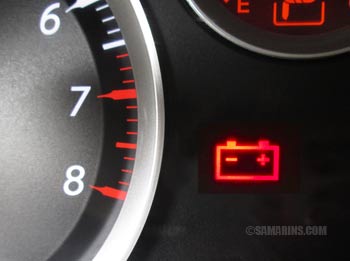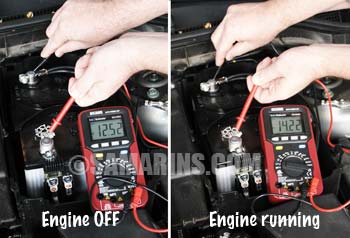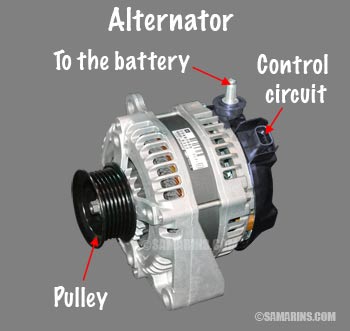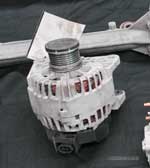Alternator, how it works, symptoms, testing, problems, replacement
Updated: May 09, 2022
An alternator is a generator of electric power in a car and is a major component of the vehicle's charging system. All cars with an internal combustion engine except for some hybrids have an alternator. When an engine is running, the alternator charges the battery and supplies additional electric power for the vehicle's electrical systems.
 Alternator. Click for a larger photo
Alternator. Click for a larger photoAn alternator is a maintenance-free unit. In some cars, it can last for up to 10-15 years without any repairs. If an alternator fails, the car may still run for a short time on battery power. However, the engine will stall as soon as the battery charge is depleted. Replacing an alternator with a new OEM part is expensive, but there are alternatives. Read more below.
Symptoms of alternator problems
The most common symptom of a problem with your vehicle's charging system is a battery-shaped warning light (in the photo) or the "CHARGE" icon that comes on while driving. Normally this warning light should come on when you turn on the ignition, but should disappear as soon as the engine is started. If it stays on, there is a problem with your charging system. The charging system warning light doesn't point directly to a failed alternator, although alternator problems are very common. Your mechanic will need to do further testing to pinpoint the defective part.How the alternator is tested
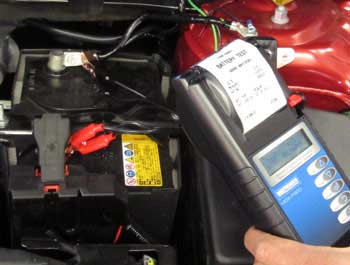 Computerized battery and charging system tester
Computerized battery and charging system testerIf the charging system fails the test, your mechanic will need to do further diagnostic to see if it's the alternator or something else causing the problem. Other charging system problems include a loose drive belt, faulty wiring or blown fuse, defective ignition switch, etc. Read also: How to Check a Fuse in a Car.
If no charging system tester is available, your mechanic can do a simple voltage test. The test involves checking the battery voltage with the engine off and with the engine running. The battery voltage should increase to more than 13.5 Volts once the engine is started, as the alternator supplies additional power (see the photo). If the battery voltage does not increase once the engine is started, there is a problem with the charging system.
Alternator replacement options
Replacing an alternator in an average car will cost from 1.0 to 2.5 hours of labor, depending on the difficulty, plus the part. A new aftermarket alternator will cost $130 to $320 (part only). An OEM alternator from a dealer will more expensive.Another alternative is to have your alternator rebuilt. The way it works is your mechanic can remove the alternator and send it to the nearest alternator/starter rebuilding shop.
Advertisement
Another money-saving option is a used or remanufactured part, especially If the supplier provides a good warranty. A used alternator can be sourced from local auto recyclers.
Whenever the alternator is replaced, it's a good idea to change the serpentine belt too. It is not very expensive, and by replacing it together with the alternator, you can save on labor, as the serpentine belt has to be removed to replace the alternator. Read more about the serpentine belt.
How to make your alternator last longer
Often an alternator fails prematurely when a protective engine undercover or shield is damaged or missing. This happens because water splashing from the road gets inside the alternator and causes it to wear faster. If your engine undershield is damaged, have it replaced to keep the engine compartment clean and dry. A coolant or oil leak can also damage the alternator. Similarly, if you have to shampoo the engine compartment, the alternator must be protected from water and detergent.How an alternator works, common problems
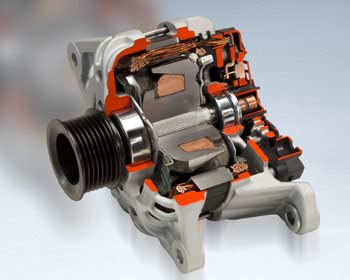 Alternator cutaway. Image courtesy of Robert Bosch GmbH
Alternator cutaway. Image courtesy of Robert Bosch GmbHThe magnetic field produced by the rotating rotor induces AC electric current in the stationary stator winding. Diodes are used to convert AC current into DC current used in the vehicle's electric system. The output voltage is controlled by the voltage regulator (photo below). Typically, a voltage regulator is built-in into the alternator.
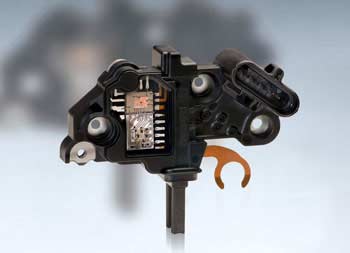 Voltage regulator. Image courtesy Robert Bosch GmbH
Voltage regulator. Image courtesy Robert Bosch GmbHBad outer and inner alternator bearings (large and small silver cylinders in the cutaway image above) can produce a whining noise. When the alternator is rebuilt, the bearings, voltage regulator, brushes and some other parts are typically replaced with new ones.
